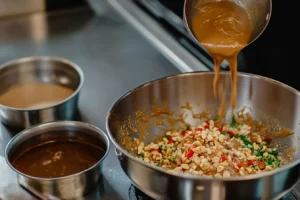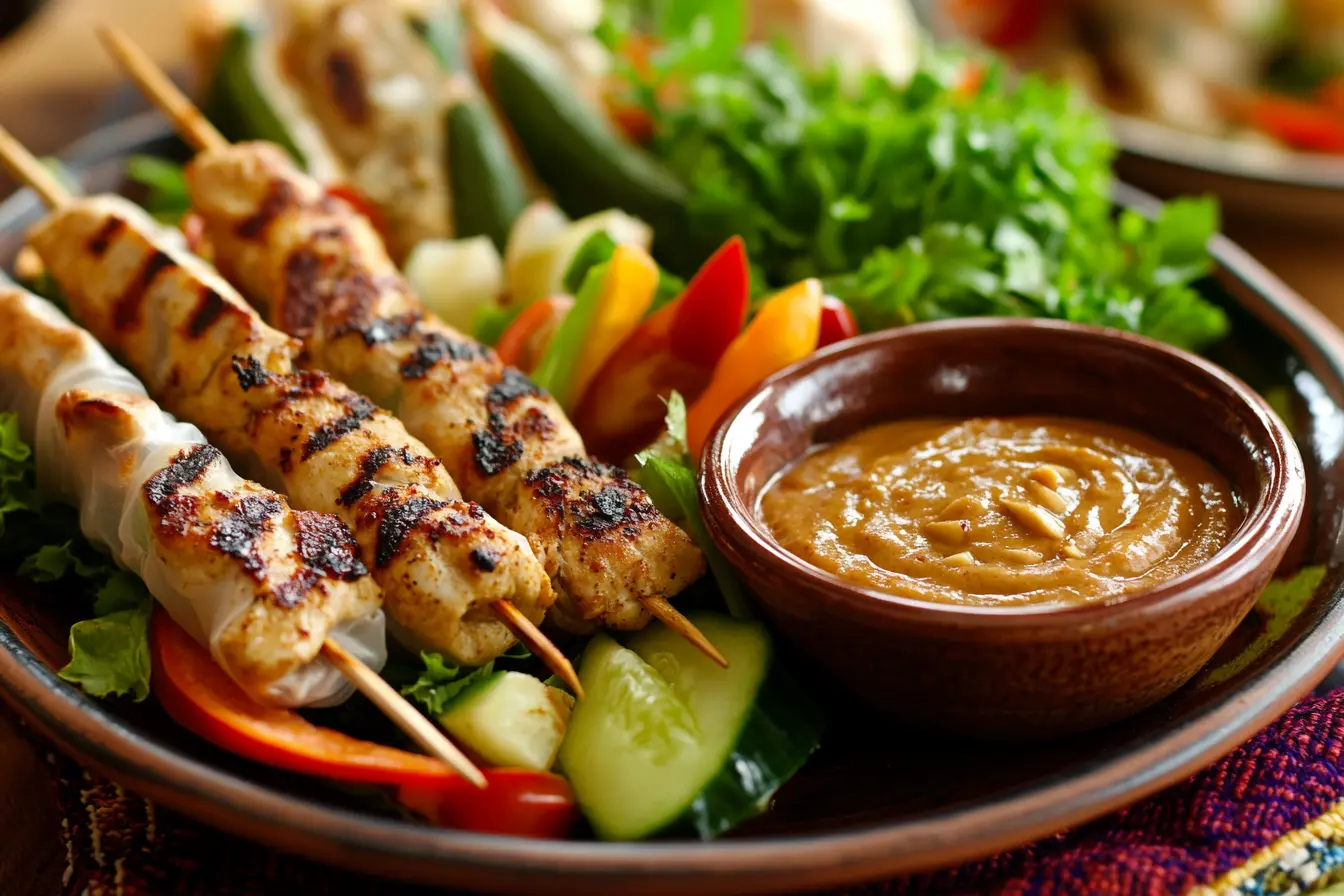Hoisin peanut sauce is an irresistibly delicious blend of sweet, savory, and nutty flavors that can elevate a variety of dishes. Whether you’re preparing a dipping sauce for spring rolls, a creamy dressing for salads, or a rich marinade for meats, this versatile sauce always delivers. In this article, we’ll uncover everything you need to know about hoisin peanut sauce, from its origins to its recipe, nutritional facts, and creative uses. Let’s dive in!
Introduction to Hoisin Peanut Sauce
What is Hoisin Peanut Sauce?
Hoisin peanut sauce is a flavorful fusion of two key culinary components: hoisin sauce and peanut butter. Hoisin sauce, a traditional Chinese condiment, brings a bold combination of sweetness and umami, while peanut butter adds a creamy, nutty depth to the mix. Together, these ingredients create a rich and velvety sauce that’s perfect for enhancing both savory and slightly sweet dishes.
This Asian-inspired sauce has become a household favorite, especially for those seeking a quick way to add an extra layer of flavor to meals. But what makes it truly stand out is its balance of taste and texture. The sweetness of hoisin complements the nuttiness of peanuts, creating a harmonious blend that’s both comforting and exciting.
Origins and Cultural Significance
The roots of hoisin sauce can be traced back to Chinese cuisine, where it was originally used as a glaze for meats or as a dipping sauce for Peking duck. Over time, this thick and flavorful sauce found its way into kitchens across the globe. When paired with peanut butter—a staple ingredient in Southeast Asian dishes—the result is the iconic hoisin peanut sauce.
While it doesn’t belong to any single cuisine, this sauce is often associated with modern Asian-inspired dishes, blending flavors from Chinese, Thai, and Vietnamese traditions. Its versatility has made it a favorite among both home cooks and chefs alike, especially in fusion recipes that bring together different cultural elements on a single plate.
A Modern Kitchen Staple
In recent years, hoisin peanut sauce has gained popularity in Western kitchens, thanks to its adaptability and rich taste. It works wonders as a dipping sauce, dressing, or marinade, and is commonly used in recipes ranging from noodle bowls to grilled skewers. Its creamy consistency and bold flavors also make it an excellent choice for experimenting with new dishes or adding a personal twist to classic recipes.
So, why not give this delicious sauce a try? You’ll find that it’s as easy to make as it is to use, with plenty of room for customization to suit your dietary preferences or flavor preferences.
Ingredients and Recipe Breakdown
Key Ingredients in Hoisin Peanut Sauce
 When it comes to crafting hoisin peanut sauce, the magic lies in its carefully selected ingredients. Each component plays a crucial role in delivering that perfect blend of sweet, savory, and nutty flavors. The best part? Most of these ingredients are pantry staples, making this sauce not only flavorful but also convenient to whip up in a pinch.
When it comes to crafting hoisin peanut sauce, the magic lies in its carefully selected ingredients. Each component plays a crucial role in delivering that perfect blend of sweet, savory, and nutty flavors. The best part? Most of these ingredients are pantry staples, making this sauce not only flavorful but also convenient to whip up in a pinch.
Core Ingredients
- Hoisin Sauce: The star of the show! Hoisin sauce is rich, sweet, and slightly tangy, with a savory umami depth that lays the foundation for this sauce.
- Peanut Butter: Creamy peanut butter adds a luscious texture and nutty taste, complementing the boldness of hoisin perfectly.
- Soy Sauce: For an extra umami kick and a touch of saltiness that balances the sweetness. Opt for low-sodium soy sauce if you prefer a lighter option.
- Garlic and Ginger: These aromatics are essential for enhancing the sauce’s complexity. Freshly minced garlic and grated ginger add warmth and a hint of spice.
- Rice Vinegar: A splash of rice vinegar introduces acidity, brightening up the flavors and preventing the sauce from feeling too heavy.
- Honey or Brown Sugar: While hoisin sauce is already sweet, a tiny bit of honey or sugar can deepen the sweetness and round out the flavors.
- Chili Flakes or Sriracha: For those who love a bit of heat, a pinch of chili flakes or a dash of sriracha can take the sauce to the next level.
- Water or Coconut Milk: To adjust the consistency. For a creamier texture, coconut milk is a great choice.
Variations for Dietary Preferences
If you have specific dietary needs, there are plenty of ways to tweak this sauce. For instance, if you’re avoiding gluten, use tamari or gluten-free soy sauce as a substitute. Need a nut-free option? Sunflower seed butter or tahini works just as well! Vegans can rejoice too, as this sauce is plant-based by default—just make sure to check your hoisin sauce label for vegan-friendly ingredients.
Step-by-Step Recipe Guide
Making hoisin peanut sauce is delightfully simple, and you don’t need to be a culinary expert to get it right. Just a few minutes, a mixing bowl, and a whisk are all you need. Here’s a foolproof recipe to help you get started:
Basic Recipe
- In a medium-sized mixing bowl, combine 1/4 cup of hoisin sauce with 3 tablespoons of creamy peanut butter.
- Add 1 tablespoon of soy sauce, 1 teaspoon of rice vinegar, and a teaspoon of freshly grated ginger.
- Mince one small garlic clove finely and stir it in.
- For sweetness, drizzle in 1 teaspoon of honey or sprinkle a pinch of brown sugar.
- If you like your sauce spicy, toss in a pinch of chili flakes or a small squeeze of sriracha.
- Gradually add 2-3 tablespoons of water or coconut milk, whisking until the sauce reaches your desired consistency.
The result? A rich, velvety hoisin peanut sauce that’s packed with flavor. You can store it in an airtight container in the fridge for up to a week.
Enhancements for Richer Flavor
For a more personalized touch, you can easily elevate this sauce with a few tweaks:
- Add a splash of lime juice for a citrusy zing.
- Mix in toasted sesame oil for a nutty aroma.
- Toss in a handful of crushed peanuts for extra texture.
This recipe is not only quick and easy, but it’s also incredibly adaptable, allowing you to adjust the flavors to suit your taste buds. With a sauce this versatile, the possibilities are endless!
Culinary Uses and Pairings
Creative Ways to Use Hoisin Peanut Sauce
One of the best things about hoisin peanut sauce is how versatile it can be. Whether you’re looking to enhance a simple meal or impress guests with complex flavors, this sauce has you covered. It elevates dishes effortlessly, making them taste richer and more satisfying.
As a Dipping Sauce
Let’s start with its most common use—dipping. From fresh spring rolls to dumplings and grilled skewers, this sauce complements appetizers perfectly. Its creamy, nutty flavor with a hint of sweetness ensures that every bite feels indulgent. Try pairing it with crisp vegetable sticks, or even chicken satay, for a restaurant-quality appetizer at home.
In Noodles and Stir-Fries
Hoisin peanut sauce is a game-changer for noodles and stir-fry dishes. Tossing warm noodles in this creamy sauce creates a quick yet satisfying meal. Moreover, the rich flavor enhances stir-fried vegetables and proteins, giving them a luscious coating that keeps every bite exciting.
Here’s an idea: sauté your favorite vegetables, like bell peppers, broccoli, and snap peas, with some tofu or shrimp. Then, mix in a few tablespoons of hoisin peanut sauce for a dish that’s not only delicious but also ready in under 30 minutes.
Pairing Suggestions for Hoisin Peanut Sauce
Proteins
This sauce pairs incredibly well with a variety of proteins. Whether you’re marinating chicken, glazing shrimp, or dressing crispy tofu, the nutty and savory flavors of hoisin peanut sauce add depth and richness. If you’re grilling, brushing it onto skewers creates a caramelized, slightly charred coating that’s irresistible.
Vegetables and Salads
Vegetables, too, come alive with hoisin peanut sauce. Roasted carrots, steamed broccoli, or sautéed green beans benefit from a drizzle of this flavorful blend. Additionally, it works wonderfully as a salad dressing. Toss it with shredded cabbage, carrots, and fresh herbs for a vibrant, Asian-inspired slaw that’s perfect as a side dish or a light lunch.
Nutritional Information and Dietary Considerations
Nutritional Profile of Hoisin Peanut Sauce
 While hoisin peanut sauce is undeniably delicious, it’s also helpful to understand its nutritional value. By doing so, you can enjoy this sauce while staying mindful of your dietary goals.
While hoisin peanut sauce is undeniably delicious, it’s also helpful to understand its nutritional value. By doing so, you can enjoy this sauce while staying mindful of your dietary goals.
Caloric Breakdown
Typically, a serving of hoisin peanut sauce (about two tablespoons) contains approximately 90-120 calories. Most of these calories come from the peanut butter, which is a rich source of healthy fats. Hoisin sauce contributes sweetness and flavor, but it’s worth noting that it can also add sugar and sodium.
Macronutrients
This sauce provides a balanced mix of macronutrients:
- Proteins: Peanut butter adds a small but meaningful amount of protein, making it a great complement to vegetable-heavy dishes.
- Fats: The majority of fats come from peanuts, which are heart-healthy and unsaturated.
- Carbohydrates: Hoisin sauce and any added sweeteners contribute to the carbohydrate count, with most coming from sugars.
For those monitoring their macros, this sauce works well in moderation, especially when paired with protein-rich or fiber-filled dishes.
Dietary Considerations and Modifications
While hoisin peanut sauce is versatile, it’s not automatically suitable for every diet. However, with a few tweaks, it can accommodate most preferences and restrictions.
Allergen-Friendly Options
If you’re allergic to peanuts, don’t worry—you can still enjoy this sauce. Simply substitute peanut butter with sunflower seed butter or tahini. Both alternatives offer a creamy texture and nutty flavor, though tahini may add a slightly bitter undertone.
For those avoiding gluten, it’s essential to use gluten-free hoisin and soy sauces. Gluten-free options are widely available and taste just as good as their traditional counterparts.
Health-Conscious Tips
If you’re trying to make healthier choices, there are ways to reduce the sugar and sodium content of the sauce. Opt for low-sodium soy sauce and use a natural sweetener, such as honey or maple syrup, instead of refined sugar. Additionally, diluting the sauce with water or coconut milk can stretch the flavor while lowering the calorie count per serving.
Tips for Storing and Preserving the Sauce
Storage Best Practices
If you’ve made a batch of hoisin peanut sauce, you’ll want to ensure it stays fresh and flavorful for as long as possible. Proper storage is crucial, not only to maintain its rich taste but also to prevent spoilage. Thankfully, storing this sauce is straightforward, and a few simple steps can make a big difference.
Refrigeration Guidelines
Once prepared, transfer the sauce into an airtight container, preferably a glass jar or BPA-free plastic container. Refrigerate it immediately, as the combination of peanut butter and hoisin sauce is prone to spoilage if left out for too long. Kept cold, the sauce typically stays fresh for up to 5-7 days.
If the sauce separates slightly during storage, don’t worry—it’s normal! Just give it a good stir before using it again. For best results, avoid storing the sauce in metal containers, as they might alter its taste over time.
Freezing Tips
For those who like to prepare in advance, freezing hoisin peanut sauce is a fantastic option. Portion the sauce into small freezer-safe containers or an ice cube tray, which makes it easy to thaw only the amount you need. Once frozen, it can last for up to three months without losing flavor.
When you’re ready to use the sauce, let it thaw in the refrigerator overnight. Reheating directly from the freezer may cause the sauce to break or change in texture, so thawing slowly is key.
How to Reuse and Reheat Hoisin Peanut Sauce
One of the best things about hoisin peanut sauce is that it’s just as versatile the second time around. But to ensure the sauce stays creamy and flavorful, it’s important to reheat it properly.
Avoiding Separation
When reheating, use low heat and stir frequently to prevent the ingredients from separating. A quick 10-15 seconds in the microwave, followed by a thorough stir, usually does the trick. If reheating on the stove, add a splash of water or coconut milk to maintain its smooth consistency.
Creative Leftover Ideas
If you have extra sauce on hand, don’t let it go to waste! It’s perfect for repurposing into new dishes:
- Use it as a base for soups, like Thai-inspired peanut soup.
- Mix it into a quinoa or rice bowl for added flavor.
- Toss it with roasted vegetables or shredded chicken for an easy meal.
By following these tips, you’ll not only extend the shelf life of your hoisin peanut sauce but also maximize its potential in your kitchen. It’s a sauce that keeps giving, even after the first use!
Variations and Regional Twists
Popular Regional Variations of Hoisin Peanut Sauce
One of the most exciting aspects of hoisin peanut sauce is how easily it adapts to regional flavors. By tweaking a few ingredients, you can create unique versions inspired by different cuisines. These variations not only add diversity to your meals but also allow you to explore new tastes without straying too far from the sauce’s classic essence.
Thai-Style Peanut Sauce
Thai cuisine has its own version of peanut sauce, which often includes coconut milk for a creamy, slightly sweet base. To transform your hoisin peanut sauce into a Thai-inspired blend, simply add:
- 2-3 tablespoons of coconut milk.
- A squeeze of lime juice for brightness.
- A teaspoon of fish sauce for an umami boost.
This version works beautifully as a dipping sauce for grilled chicken satay or as a dressing for Thai noodle salads.
Vietnamese-Inspired Blend
Vietnamese cuisine often features sauces that combine bold flavors with a light and refreshing twist. For a Vietnamese-style variation:
- Incorporate 1 teaspoon of fish sauce.
- Add chopped fresh herbs like cilantro and Thai basil.
- Toss in a dash of sriracha for a subtle kick.
This variation is excellent with fresh spring rolls or as a dipping sauce for summer rolls. The addition of fresh herbs gives the sauce a bright, aromatic profile that pairs perfectly with lighter dishes.
DIY Hoisin Sauce for Custom Blends
If you love experimenting in the kitchen, you might enjoy making your own hoisin sauce from scratch. Homemade hoisin allows you to control the sweetness, saltiness, and spice levels, making it a perfect base for personalized peanut sauce blends.
Homemade Hoisin Sauce Recipe
To prepare your own hoisin sauce, combine the following in a blender or mixing bowl:
- 1/4 cup of soy sauce.
- 2 tablespoons of peanut butter or black bean paste.
- 1 tablespoon of honey or brown sugar.
- 1 teaspoon of rice vinegar.
- A pinch of garlic powder, five-spice powder, and chili flakes.
Blend until smooth, and use it immediately or store it in the fridge for up to a week. With this homemade version, you’ll have a fully customizable foundation for your hoisin peanut sauce.
Adjusting Sweetness and Spice Levels
No matter the variation, adjusting sweetness and spice levels is key to making the sauce truly your own. For those who prefer a sweeter flavor, consider adding honey, brown sugar, or even maple syrup. If you’re a fan of spicy sauces, increase the heat by adding chili paste, sriracha, or crushed red pepper flakes.
By exploring these regional twists and customizations, you’ll never run out of ways to enjoy hoisin peanut sauce. Whether you stick with the classic version or venture into new territory, the possibilities are nearly endless!
Frequently Asked Questions (FAQs)
Can I make hoisin peanut sauce without peanut butter?
Absolutely! If you’re avoiding peanut butter due to allergies or personal preference, there are several alternatives to consider. Almond butter, sunflower seed butter, or tahini can all serve as excellent substitutes. While the flavor will differ slightly, these options still provide a creamy texture and nutty taste.
Is hoisin peanut sauce gluten-free?
It depends on the ingredients you use. Many store-bought hoisin sauces and soy sauces contain gluten, so it’s important to check the labels. To make a gluten-free version, use tamari or coconut aminos as a soy sauce alternative, and look for a certified gluten-free hoisin sauce.
How long does homemade hoisin peanut sauce last?
When stored properly in an airtight container and kept refrigerated, homemade hoisin peanut sauce typically lasts 5-7 days. However, if you’ve added fresh ingredients like herbs or lime juice, it’s best to consume the sauce within 4-5 days to maintain its freshness and flavor.
What dishes pair best with hoisin peanut sauce?
The versatility of this sauce means it pairs well with a wide range of dishes. It’s perfect for dipping spring rolls and dumplings, dressing noodle salads, marinating chicken or tofu, and even drizzling over roasted vegetables. Its ability to complement both savory and slightly sweet dishes makes it an invaluable addition to your culinary repertoire.
Can I make a spicy version of hoisin peanut sauce?
Of course! To add a kick of heat, mix in chili paste, sriracha, or crushed red pepper flakes. You can also experiment with fresh chili peppers for a more intense flavor. Adjust the spice level to your liking by starting with a small amount and gradually increasing until it’s just right.

